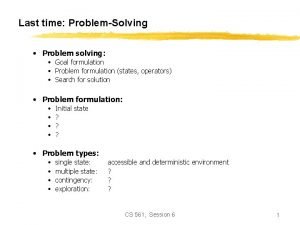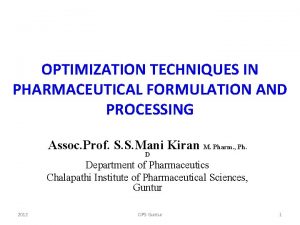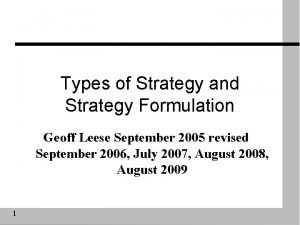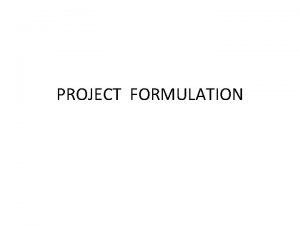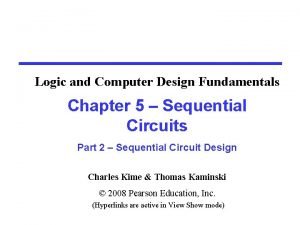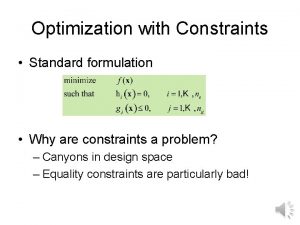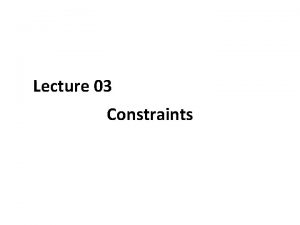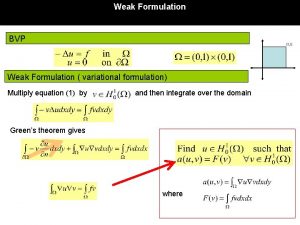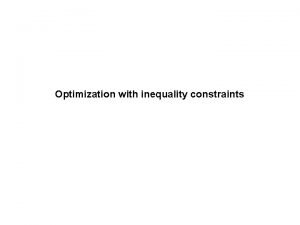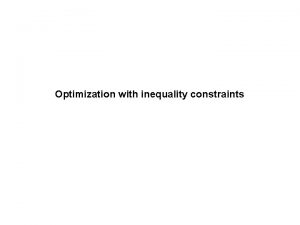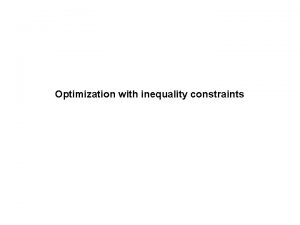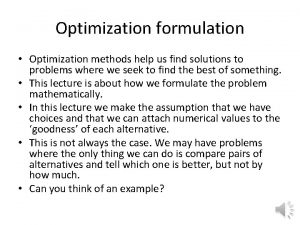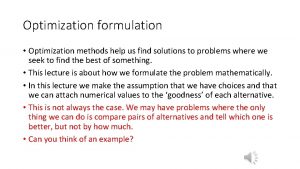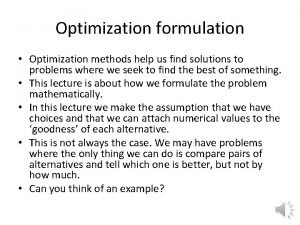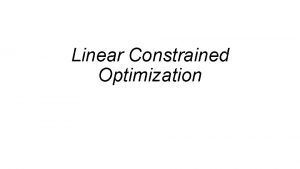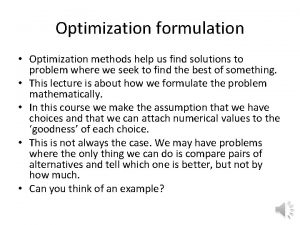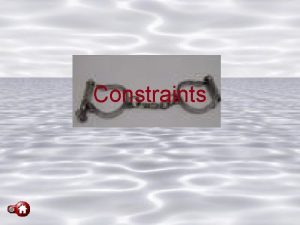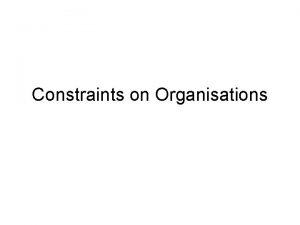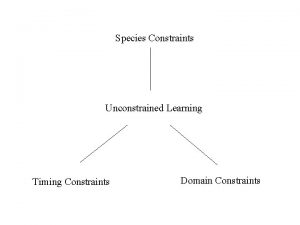Optimization with Constraints Standard formulation Why are constraints














![Useful additional information [X, FVAL, EXITFLAG] = fmincon(FUN, X 0, . . . ) Useful additional information [X, FVAL, EXITFLAG] = fmincon(FUN, X 0, . . . )](https://slidetodoc.com/presentation_image_h/0c07a83536f50a3f63d7a76fdee4c772/image-15.jpg)

![Making it harder for fmincon • >> a=1. 1; • [x, fval]=fmincon(@quad 2, x Making it harder for fmincon • >> a=1. 1; • [x, fval]=fmincon(@quad 2, x](https://slidetodoc.com/presentation_image_h/0c07a83536f50a3f63d7a76fdee4c772/image-17.jpg)

- Slides: 18

Optimization with Constraints • Standard formulation • Why are constraints a problem? – Canyons in design space – Equality constraints are particularly bad!

Derivative-based optimizers • All are predicated on the assumption that function evaluations are expensive and gradients can be calculated. • Similar to a person put at night on a hill and directed to find the lowest point in an adjacent valley using a flashlight with limited battery • Basic strategy: 1. Flash light to get derivative and select direction. 2. Go straight in that direction until you start going up or hit constraint. 3. Repeat until converged. • Steepest descent does not work well. For unconstrained problems use quasi-Newton methods.

Gradient projection and reduced gradient methods • Find good direction tangent to active constraints • Move a distance and then restore to constraint boundaries • How do we decide when to stop and restore?

The Feasible Directions method • Compromise constraint avoidance and objective reduction

Penalty function methods • Quadratic penalty function • Gradual rise of penalty parameter leads to sequence of unconstrained minimization technique (SUMT). Why is it important?

Example 5. 7. 1

Contours for r=1.

Contours for r=10.

Contours for r=100.

Contours for r=1000. For non-derivative methods can avoid this by having penalty proportional to absolute value of violation instead of its square!

Multiplier methods • By adding the Lagrange multipliers to penalty term can avoid ill-conditioning associated with high penalty

Can estimate Lagrange multipliers • Stationarity • Without penalty • So: • Iterate See example in textbook

5. 9: Projected Lagrangian methods • Sequential quadratic programming • Find direction by solving • Find alpha by minimizing

Matlab function fmincon FMINCON attempts to solve problems of the form: min F(X) subject to: A*X <= B, Aeq*X = Beq (linear cons) X C(X) <= 0, Ceq(X) = 0 (nonlinear cons) LB <= X <= UB X=FMINCON(FUN, X 0, A, B, Aeq, Beq, LB, UB, NONLCON) subjects the minimization to the constraints defined in NONLCON. The function NONLCON accepts X and returns the vectors C and Ceq, representing the nonlinear inequalities and equalities respectively. (Set LB=[] and/or UB=[] if no bounds exist. ) [X, FVAL]=FMINCON(FUN, X 0, . . . ) returns the value of the objective function FUN at the solution X. What does the order of arguments in fmincon tell you about the expectations of Matlab on the most common problems to be solved?
![Useful additional information X FVAL EXITFLAG fminconFUN X 0 Useful additional information [X, FVAL, EXITFLAG] = fmincon(FUN, X 0, . . . )](https://slidetodoc.com/presentation_image_h/0c07a83536f50a3f63d7a76fdee4c772/image-15.jpg)
Useful additional information [X, FVAL, EXITFLAG] = fmincon(FUN, X 0, . . . ) returns an EXITFLAG that describes the exit condition of fmincon. Possible values of EXITFLAG 1 First order optimality conditions satisfied. 0 Too many function evaluations or iterations. -1 Stopped by output/plot function. -2 No feasible point found. [X, FVAL, EXITFLAG, OUTPUT, LAMBDA] = fmincon(FUN, X 0, . . . ) returns Lagrange multipliers at the solution X: LAMBDA. lower for LB, LAMBDA. upper for UB, LAMBDA. ineqlin is for the linear inequalities, LAMBDA. eqlin is for the linear equalities, LAMBDA. ineqnonlin is for the nonlinear inequalities, and LAMBDA. eqnonlin is for the nonlinear equalities.

Ring Example Quadratic function and constraint function f=quad 2(x) Global a f=x(1)^2+a*x(2)^2; function [c, ceq]=ring(x) global ri ro c(1)=ri^2 -x(1)^2 -x(2)^2; c(2)=x(1)^2+x(2)^2 -ro^2; ceq=[]; x 0=[1, 10]; a=10; ri=10. ; ro=20; [x, fval]=fmincon(@quad 2, x 0, [], [], [], @ring) x =10. 0000 -0. 0000 fval =100. 0000
![Making it harder for fmincon a1 1 x fvalfminconquad 2 x Making it harder for fmincon • >> a=1. 1; • [x, fval]=fmincon(@quad 2, x](https://slidetodoc.com/presentation_image_h/0c07a83536f50a3f63d7a76fdee4c772/image-17.jpg)
Making it harder for fmincon • >> a=1. 1; • [x, fval]=fmincon(@quad 2, x 0, [], [], [], @ring) • Warning: Trust-region-reflective method does not currently solve this type of problem, • using active-set (line search) instead. • > In fmincon at 437 • Maximum number of function evaluations exceeded; • increase OPTIONS. Max. Fun. Evals. • x =4. 6355 8. 9430 fval =109. 4628

Restart sometimes helps >>x 0=x x 0 = 4. 6355 8. 9430 >> [x, fval]=fmincon(@quad 2, x 0, [], [], [], @ring) • x =10. 0000 • fval =100. 0000 • Why restarting a solution is often more effective than having a large number of iterations in the original search?
 Antigentest åre
Antigentest åre Why problem formulation follow goal formulation
Why problem formulation follow goal formulation Optimization techniques in pharmaceutical formulation
Optimization techniques in pharmaceutical formulation Pictures
Pictures Dont ask why why why
Dont ask why why why What is standard error
What is standard error Power dynamics of standard language vs home language
Power dynamics of standard language vs home language Definition of standard costing
Definition of standard costing Peruntukan masa kssm 2021 menengah rendah
Peruntukan masa kssm 2021 menengah rendah Strategic hrm models
Strategic hrm models Types of strategy formulation
Types of strategy formulation Spin finish oil formulation
Spin finish oil formulation Descriptive research design
Descriptive research design Project formulation definition
Project formulation definition Investment management process steps
Investment management process steps Product formulation statement
Product formulation statement The monophasic liquid dosage form is solution
The monophasic liquid dosage form is solution Nysed cn
Nysed cn Fundamentals of logical computing formulation
Fundamentals of logical computing formulation

